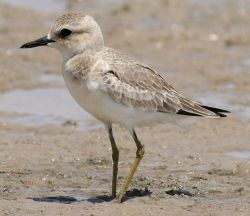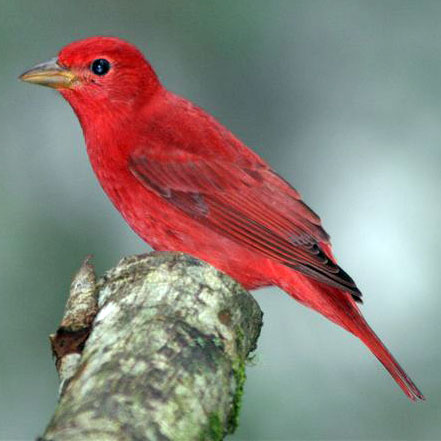Accidental Avian Tourists
Posted by: Loren Coleman on May 31st, 2009
Out-of-place birds are called “accidentals” in the birdwatching trade. There are no jumps in logic that the birds are teleporting from other countries or have escaped from traveling circuses (most of the time). It is quite reasonably assumed that, now and then, a few birds, which can fly great distances, have gotten off-course.
Needless to say, very few people can match Marlon Lowe’s April 1977 “Thunderbird sighting” near Lawndale, Illinois, for first place on a lifelist, but there are personal rewards to birdwatching.
Here is a roundup of some recent “weird” bird sightings for May 2009, demonstrating the typical kinds of “accidental avian tourists” that cross my desk.
(1)
“Asian bird spotted on Florida beach”
Bird watchers are migrating thousands of miles to Florida for a chance to see an Asian bird that has shown up in a Jacksonville park.
Volunteers doing a census in Huguenot Memorial Park spotted the greater sand plover last week, The Orlando Sentinel reports. The species breeds in Turkey and central Asia and winters on Mediterranean and Indian Ocean beaches.
A greater sand plover was spotted in California in 2001, the first time it was reported in the Americas. Reports of the Florida bird have lured birdwatchers from distances almost as great as the one it traveled.
“We have seen an influx of bird-watchers from as far as California,” said Ben Pennymon, a spokesman for Jacksonville.
Pennymon said the bird has kept to a section of the park where off-road vehicles are banned from the beach.
“It is a really big deal, especially because the first sighting in California, the bird was in its dull winter plumage, but this bird is in its beautiful breeding plumage,” said Wes Biggs of Orlando, who has already made the pilgrimage to Jacksonville.
(2)
“Out-of-place bird spotted north of Great Falls”
A pair of Great Falls birdwatchers have recorded what is believed to be only the third verified sighting of the summer tanager in Montana.
Sharon Dewart-Hansen and her husband, Doug Hansen, were visiting Benton Lake north of Great Falls on Sunday when they spotted a splash of red feathers on a nearby tree. Dewart-Hansen snapped the first documented photo of the bird taken in the state.
Jeff Marks, former director of the Montana Audubon Society’s Bird Conservancy, verified the sighting after seeing the photographs. He said the summer tanager normally lives significantly south and east of Montana, with the closest known breeder along the Missouri River in Iowa.
The last valid sighting of the bird in Montana was May 17, 1997, in Billings. The one before that was in November 1981. Marks said there were three sightings listed in the Montana Field Guide, but only two of those were verified.
(3)

This rare yellow-billed loon was spotted at Rockport Reservoir recently. (Kri Van Fleet /)
“Bird sighting: Yellow-billed loon”
The recent Great Salt Lake Bird Festival ended on a high note when Tim Avery and a group of birders from Utah and Texas spotted a yellow-billed Loon at Rockport Reservoir. Avery was leading the Marathon Birding Day field trip, which seeks the maximum number of species in a single day (his group saw 128 species.) The highlight, though, was the yellow-billed loon, which was a life bird for all of the participants, including Avery.
Kris Van Fleet was able to capture this image, so the sighting can be documented by the Utah Ornithological Society’s Rare Bird Committee. It was a life bird for Van Fleet too. Birding enthusiasts from all over northern Utah are “flocking” to Rockport to see this rare migrating loon.
The yellow-billed loon is the largest of the world’s loons. It is an Arctic species and occurs in Eurasia, as well as North America. Its winter range is the Pacific Ocean off southern Alaska and British Columbia. Yellow-billed loons always breed north of the tree line and are not common anywhere they occur. A yellow-billed appearance in Utah is a rare occurrence.
Many birders would pass off the yellow-billed loon as a common loon, which is typically seen in Utah’s larger reservoirs during spring migration. The biggest difference is the yellow bill, which is longer, larger and angles upward. The upper body is a pattern of black with white spots. Its underbody is white.
***
May 28, 2009/The Salt Lake Tribune
(4)

Thirsty peacock visits Julie Larson’s back yard in Independence, Minnesota.
“Drought brings strange bird to Independence backyard”
“This is one I had to see to believe. I knew birds were drought stressed when I turned my sprinkler on at the Huttner Weather Lab Thursday and birds immediately started flocking from the trees for a drink. But I never saw a bird the like one above. All Things Considered producer Jeff Jones explains below. Thanks to MPR weather spy Julie Larson for the proof!” ~ PH
At first, we didn’t believe Julie Larson when she responded to our All Things Considered text message query about the effect of the dry weather in our listeners’ back yards. Here’s what she wrote: “A peacock has surfaced in our yard and drinks from our bird bath!”
I called her back and she insisted the sighting was for real. Could it be a wild turkey? No. If you’ve ever heard a peacock squawk, you’d know it’s the real thing, she said. To further prove it, she sent us these photos of the colorful visitor — which she has named Waldo (“So I can ask the kids, ‘Where’s Waldo?'”, she says).
The Larsons live in a wooded area in Independence, MN — about 25 miles west of Minneapolis. Julie says Waldo the Peacock visits frequently to drink from the bath and get some seeds at the Larson bird feeder. “He comes for three squares a day,” she says. Just as songbirds appear after a lawn sprinkler runs, Julie suspects the dry weather is making it hard for Waldo to find water elsewhere. She’s had coyotes in her yard, too, and she hopes (for Waldo’s sake) they don’t decide to visit at the same time.
I called our good friend and top-flight bird expert Carrol Henderson from the DNR, who’s heard it all when it comes to Minnesota bird sightings. He confirmed that Minnesota is not along the typical peacock migration path (the birds are only native to South Asia and central Africa). He suspects Waldo escaped from a nearby hobby farm. Julie Larson says she knows of no such farms near her community. Until someone comes around to claim him — or until we finally get some rain — she’ll keep filling up the bird bath so Waldo can beat the heat.
May 29, 2009/Paul Huttner/Jeff Jones/Minnesota Public Radio
+++++
There you have it, three true “accidentals” and one rather obviously escaped pet, which is rather typical for springtime in America.
What have been your notable “accidentals” on your lifelist? ~ Loren
About Loren Coleman
Loren Coleman is one of the world’s leading cryptozoologists, some say “the” leading living cryptozoologist. Certainly, he is acknowledged as the current living American researcher and writer who has most popularized cryptozoology in the late 20th and early 21st centuries.
Starting his fieldwork and investigations in 1960, after traveling and trekking extensively in pursuit of cryptozoological mysteries, Coleman began writing to share his experiences in 1969. An honorary member of Ivan T. Sanderson’s Society for the Investigation of the Unexplained in the 1970s, Coleman has been bestowed with similar honorary memberships of the North Idaho College Cryptozoology Club in 1983, and in subsequent years, that of the British Columbia Scientific Cryptozoology Club, CryptoSafari International, and other international organizations. He was also a Life Member and Benefactor of the International Society of Cryptozoology (now-defunct).
Loren Coleman’s daily blog, as a member of the Cryptomundo Team, served as an ongoing avenue of communication for the ever-growing body of cryptozoo news from 2005 through 2013. He returned as an infrequent contributor beginning Halloween week of 2015.
Coleman is the founder in 2003, and current director of the International Cryptozoology Museum in Portland, Maine.












All but the peacock are probably true accidentals. The peacock is probably a stray pet. Thousands of people have peacocks and other exotic pheasants, and not just on farms. They are very, very popular. I have had a couple of them myself. You can buy them from almost any poultry hatchery.
There is not much worse than reading through an article and having a great comment to leave only to find someone else already beat you to it. This time, that “not-so-stray-cat” Kittenz beat me to the punch. I totally agree, since I too raise exotic and domestic birds.
3 or 4 years ago, I spotted what I am certain was an Emperor goose, amongst a flock of Canada geese in the pond of one of our local parks in Petaluma, California. I observed it for the better part of an hour, sometimes at fairly close range – fewer than 50 feet away. I’d already seen a single Ross’s Goose associating with a group of Canada Geese in the same location, twice in previous years. Before calling the sighting in to the Audubon rare bird alert, I checked to see if the Emperor goose had ever been seen in the area before. Sure enough, there was a confirmed sighting a few miles West, in Bodega Bay, back in 1996. Discovering “accidentals” while looking for more expected birds is really exciting fun for me. Then again, some of my friends consider me the nerdiest of us all due to my birdwatching proclivities. But I see that as a badge of honor, LOL!
Right from the others about peacocks. I remember hearing that distinctive call while on a backpacking trip in Virginia. I went holy….but then realized that the trail was passing somewhat close to civilization at that point, and I was probably hearing a pet.